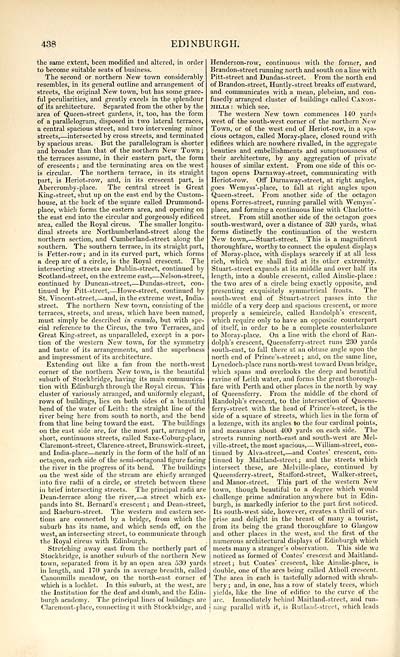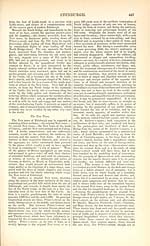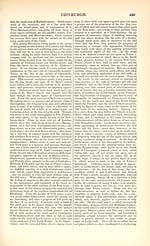Topographical, statistical, and historical gazetteer of Scotland > Volume 1
(528) Page 438
Download files
Complete book:
Individual page:
Thumbnail gallery: Grid view | List view

438
EDINBURGH.
the same extent, been modified and altered, in order
to become suitable seats of business.
The second or northern New town considerably
resembles, in its general outline and arrangement of
streets, the original New town, but has some grace-
ful peculiarities, and greatly excels in the splendour
of its architecture. Separated from the other by the
area of Queen-street gardens, it, too, has the form
of a parallelogram, disposed in two lateral terraces,
a central spacious street, and two intervening minor
streets, — intersected by cross streets, and terminated
by spacious areas. But the parallelogram is shorter
and broader than that of the northern New Town ;
the terraces assume, in their eastern part, the form
of crescents ; and the terminating area on the west
is circular. The northern terrace, in its straight
part, is Heriot-row, and, in its crescent part, is
Abercromby-place. The central street is Great
King-street, shut up on the east end by the Custom-
house, at the back of the square called Drummond-
place, which forms the eastern area, and opening on
the east end into the circular and gorgeously edificed
area, called the Royal circus. The smaller longitu-
dinal streets are Northumberland-street along the
northern section, and Cumberland-street along the
southern. The southern terrace, in its straight part,
is Fetter-row ; and in its curved part, which forms
a deep arc of a circle, is the Royal crescent. The
intersecting streets are Dublin-street, continued by
Scotland-street, on the extreme east, — Nelson-street,
continued by Duncan-street, — Dundas-street, con-
tinued by Pitt-street, — Howe-street, continued by
St. Vincent-street, — and, in the extreme west, India-
street. The northern New town, consisting of the
terraces, streets, and areas, winch have been named,
must simply be described in cumulo, but with spe-
cial reference to the Circus, the two Terraces, and
Great King-street, as unparalleled, except in a por-
tion of the western New town, for the symmetry
and taste of its arrangements, and the superbness
and impressment of its architecture.
Extending out like a fan from the north-west
corner of the northern New town, is the beautiful
suburb of Stockbridge, having its main communica-
tion with Edinburgh through the Royal circus. This
cluster of variously arranged, and uniformly elegant,
rows of buildings, lies on both sides of a beautiful
bend of the water of Leith : the straight line of the
river being here from south to north, and the bend
from that line being toward the east. The buildings
on the east side are, for the most part, arranged in
short, continuous streets, called Saxe-Coburg-place,
Claremont-street, Clarence-street, Brunswick-street,
and India-place — nearly in the form of the half of an
octagon, each side of the semi-octagonal figure facing
the river in the progress of its bend. The buildings
on the west side of the stream are chiefly arranged
into five radii of a circle, or stretch between these
in brief intersecting streets. The principal radii are
Dean-terrace along the river, — a street which ex-
pands into St. Bernard's crescent ; and Dean-street,
and Raeburn-street. The western and eastern sec-
tions are connected by a bridge, from which the
suburb has its name, and which sends off, on the
west, an intersecting street, to communicate through
the Royal circus with Edinburgh.
Stretching away east from the northerly part of
Stockbridge, is another suburb of the northern New
town, separated from it by an open area 530 yards
in length, and 170 yards in average breadth, called
Canonmills meadow, on the north-east corner of
which is a lochlet. In this suburb, at the west, are
the Institution for the deaf and dumb, and the Edin-
burgh academy. The principal lines of buildings are
Claremont-place, connecting it with Stockbridge, and
Henderson-row, continuous with the former, and
Brandon-street running north and south on a line with
Pitt-street and Dundas-street. From the north end
of Brandon-street, Huntly-street breaks off eastward,
and communicates with a mean, plebeian, and con-
fusedly arranged cluster of buildings called Canon-
mills : which see.
The western New town commences 140 yards
west of the south-west corner of the northern New
Town, or of the west end of Heriot-row, in a spa-
cious octagon, called Moray-place, closed round with
edifices which are nowhere rivalled, in the aggregate
beauties and embellishments and sumptuousness of
their architecture, by any aggregation of private
houses of similar extent. From one side of this oc-
tagon opens Darnaway-street, communicating with
Heriot-row. Off Darnaway-street, at right angles,
goes Wemyss'-place, to fall at right angles upon
Queen-street. From another side of the octagon
opens Forres-street, running parallel with Wemyss'-
place, and forming a continuous line with Charlotte-
street. From still another side of the octagon goes
south-westward, over a distance of 320 yards, what
forms distinctly the continuation of the western
New town, — Stuart- street. This is a magnificent
thoroughfare, worthy to connect the opulent displays
of Moray-place, with displays scarcely if at all less
rich, which we shall find at its other extremity.
Stuart- street expands at its middle and over half its
length, into a double crescent, called Ainslie-place :
the two arcs of a circle being exactly opposite, and
presenting exquisitely symmetrical fronts. The
south-west end of Stuart-street passes into the
middle of a very deep and spacious crescent, or more
properly a semicircle, called Randolph's crescent,
which require only to have an opposite counterpart
of itself, in order to be a complete counterbalance
to Moray-place. On a line with the chord of Ran-
dolph's crescent, Queensferry-street runs 230 yards
south-east, to fall there at an obtuse angle upon the
north end of Prince 's-street ; and, on the same line,
Lynedoch-place runs north-west toward Dean bridge,
which spans and overlooks the deep and beautiful
ravine of Leith water, and forms the great thorough-
fare with Perth and other places in the north by way
of Queensferry. From the middle of the chord of
Randolph's crescent, to the intersection of Queens-
ferry-street with the head of Prince's-street, is the
side of a square of streets, which Ues in the form of
a lozenge, with its angles to the four cardinal points,
and measures about 400 yards on each side. The
streets running north-east and south-west are Mel-
ville-street, the most spacious, — William-street, con-
tinued by Alva-street, — and Coates' crescent, con-
tinued by Maitland-street ; and the streets which
intersect these, are Melville-place, continued by
Queensferry-street, Stafford-street, Walker-street,
and Manor-street. This part of the western New
town, though beautiful to a degree which would
challenge prime admiration anywhere but in Edin-
burgh, is markedly inferior to the part first noticed.
Its south-west side, however, creates a thrill of sur-
prise and delight in the breast of many a tourist,
from its being the grand thoroughfare to Glasgow
and other places in the west, and the first of the
numerous architectural displays of Edinburgh which
meets many a stranger's observation. This side we
noticed as formed of Coates' crescent and Maitland-
street; but Coates' crescent, like Ainslie-place, is
double, one of the arcs being called Atholl crescent.
The area in each is tastefully adorned with shrub-
bery ; and, in one, has a row of stately trees, which
yields, like the line of edifice to the curve of the
arc. Immediately behind Maitland-street, and run-
ning parallel with it, is Rutland-street, which leads
EDINBURGH.
the same extent, been modified and altered, in order
to become suitable seats of business.
The second or northern New town considerably
resembles, in its general outline and arrangement of
streets, the original New town, but has some grace-
ful peculiarities, and greatly excels in the splendour
of its architecture. Separated from the other by the
area of Queen-street gardens, it, too, has the form
of a parallelogram, disposed in two lateral terraces,
a central spacious street, and two intervening minor
streets, — intersected by cross streets, and terminated
by spacious areas. But the parallelogram is shorter
and broader than that of the northern New Town ;
the terraces assume, in their eastern part, the form
of crescents ; and the terminating area on the west
is circular. The northern terrace, in its straight
part, is Heriot-row, and, in its crescent part, is
Abercromby-place. The central street is Great
King-street, shut up on the east end by the Custom-
house, at the back of the square called Drummond-
place, which forms the eastern area, and opening on
the east end into the circular and gorgeously edificed
area, called the Royal circus. The smaller longitu-
dinal streets are Northumberland-street along the
northern section, and Cumberland-street along the
southern. The southern terrace, in its straight part,
is Fetter-row ; and in its curved part, which forms
a deep arc of a circle, is the Royal crescent. The
intersecting streets are Dublin-street, continued by
Scotland-street, on the extreme east, — Nelson-street,
continued by Duncan-street, — Dundas-street, con-
tinued by Pitt-street, — Howe-street, continued by
St. Vincent-street, — and, in the extreme west, India-
street. The northern New town, consisting of the
terraces, streets, and areas, winch have been named,
must simply be described in cumulo, but with spe-
cial reference to the Circus, the two Terraces, and
Great King-street, as unparalleled, except in a por-
tion of the western New town, for the symmetry
and taste of its arrangements, and the superbness
and impressment of its architecture.
Extending out like a fan from the north-west
corner of the northern New town, is the beautiful
suburb of Stockbridge, having its main communica-
tion with Edinburgh through the Royal circus. This
cluster of variously arranged, and uniformly elegant,
rows of buildings, lies on both sides of a beautiful
bend of the water of Leith : the straight line of the
river being here from south to north, and the bend
from that line being toward the east. The buildings
on the east side are, for the most part, arranged in
short, continuous streets, called Saxe-Coburg-place,
Claremont-street, Clarence-street, Brunswick-street,
and India-place — nearly in the form of the half of an
octagon, each side of the semi-octagonal figure facing
the river in the progress of its bend. The buildings
on the west side of the stream are chiefly arranged
into five radii of a circle, or stretch between these
in brief intersecting streets. The principal radii are
Dean-terrace along the river, — a street which ex-
pands into St. Bernard's crescent ; and Dean-street,
and Raeburn-street. The western and eastern sec-
tions are connected by a bridge, from which the
suburb has its name, and which sends off, on the
west, an intersecting street, to communicate through
the Royal circus with Edinburgh.
Stretching away east from the northerly part of
Stockbridge, is another suburb of the northern New
town, separated from it by an open area 530 yards
in length, and 170 yards in average breadth, called
Canonmills meadow, on the north-east corner of
which is a lochlet. In this suburb, at the west, are
the Institution for the deaf and dumb, and the Edin-
burgh academy. The principal lines of buildings are
Claremont-place, connecting it with Stockbridge, and
Henderson-row, continuous with the former, and
Brandon-street running north and south on a line with
Pitt-street and Dundas-street. From the north end
of Brandon-street, Huntly-street breaks off eastward,
and communicates with a mean, plebeian, and con-
fusedly arranged cluster of buildings called Canon-
mills : which see.
The western New town commences 140 yards
west of the south-west corner of the northern New
Town, or of the west end of Heriot-row, in a spa-
cious octagon, called Moray-place, closed round with
edifices which are nowhere rivalled, in the aggregate
beauties and embellishments and sumptuousness of
their architecture, by any aggregation of private
houses of similar extent. From one side of this oc-
tagon opens Darnaway-street, communicating with
Heriot-row. Off Darnaway-street, at right angles,
goes Wemyss'-place, to fall at right angles upon
Queen-street. From another side of the octagon
opens Forres-street, running parallel with Wemyss'-
place, and forming a continuous line with Charlotte-
street. From still another side of the octagon goes
south-westward, over a distance of 320 yards, what
forms distinctly the continuation of the western
New town, — Stuart- street. This is a magnificent
thoroughfare, worthy to connect the opulent displays
of Moray-place, with displays scarcely if at all less
rich, which we shall find at its other extremity.
Stuart- street expands at its middle and over half its
length, into a double crescent, called Ainslie-place :
the two arcs of a circle being exactly opposite, and
presenting exquisitely symmetrical fronts. The
south-west end of Stuart-street passes into the
middle of a very deep and spacious crescent, or more
properly a semicircle, called Randolph's crescent,
which require only to have an opposite counterpart
of itself, in order to be a complete counterbalance
to Moray-place. On a line with the chord of Ran-
dolph's crescent, Queensferry-street runs 230 yards
south-east, to fall there at an obtuse angle upon the
north end of Prince 's-street ; and, on the same line,
Lynedoch-place runs north-west toward Dean bridge,
which spans and overlooks the deep and beautiful
ravine of Leith water, and forms the great thorough-
fare with Perth and other places in the north by way
of Queensferry. From the middle of the chord of
Randolph's crescent, to the intersection of Queens-
ferry-street with the head of Prince's-street, is the
side of a square of streets, which Ues in the form of
a lozenge, with its angles to the four cardinal points,
and measures about 400 yards on each side. The
streets running north-east and south-west are Mel-
ville-street, the most spacious, — William-street, con-
tinued by Alva-street, — and Coates' crescent, con-
tinued by Maitland-street ; and the streets which
intersect these, are Melville-place, continued by
Queensferry-street, Stafford-street, Walker-street,
and Manor-street. This part of the western New
town, though beautiful to a degree which would
challenge prime admiration anywhere but in Edin-
burgh, is markedly inferior to the part first noticed.
Its south-west side, however, creates a thrill of sur-
prise and delight in the breast of many a tourist,
from its being the grand thoroughfare to Glasgow
and other places in the west, and the first of the
numerous architectural displays of Edinburgh which
meets many a stranger's observation. This side we
noticed as formed of Coates' crescent and Maitland-
street; but Coates' crescent, like Ainslie-place, is
double, one of the arcs being called Atholl crescent.
The area in each is tastefully adorned with shrub-
bery ; and, in one, has a row of stately trees, which
yields, like the line of edifice to the curve of the
arc. Immediately behind Maitland-street, and run-
ning parallel with it, is Rutland-street, which leads
Set display mode to: Large image | Transcription
Images and transcriptions on this page, including medium image downloads, may be used under the Creative Commons Attribution 4.0 International Licence unless otherwise stated. ![]()
| Gazetteers of Scotland, 1803-1901 > Topographical, statistical, and historical gazetteer of Scotland > Volume 1 > (528) Page 438 |
|---|
| Permanent URL | https://digital.nls.uk/97443882 |
|---|
| Description | Volume first. A-H. |
|---|---|
| Attribution and copyright: |
|

